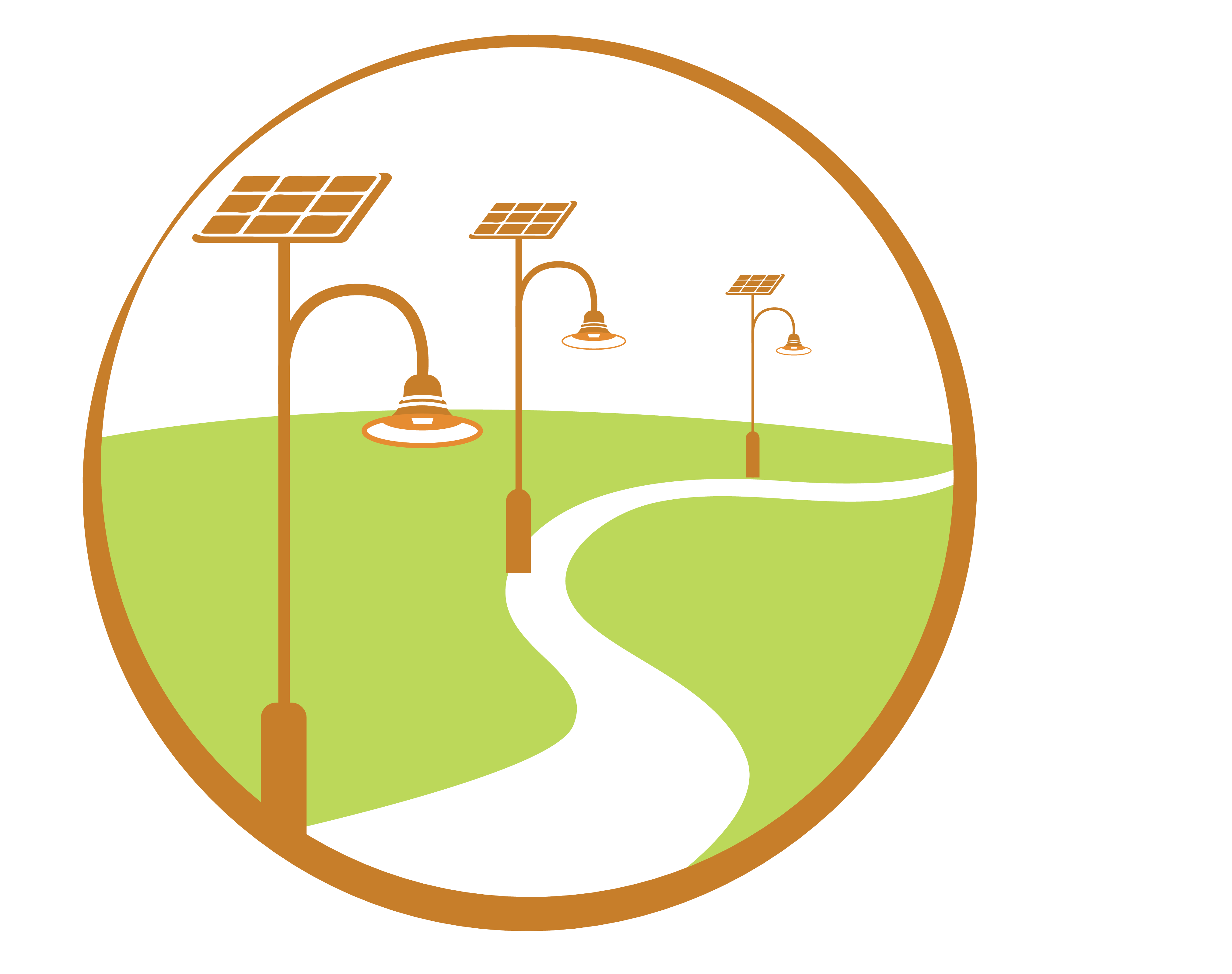Table of Contents
Solar lighting is a fantastic choice in opposition to traditional grid-tie lighting because of how cost-effective it is. In sun-heavy areas, these lights have a 5-day autonomy meaning they can operate on battery power without any recharging for 5 cycles.
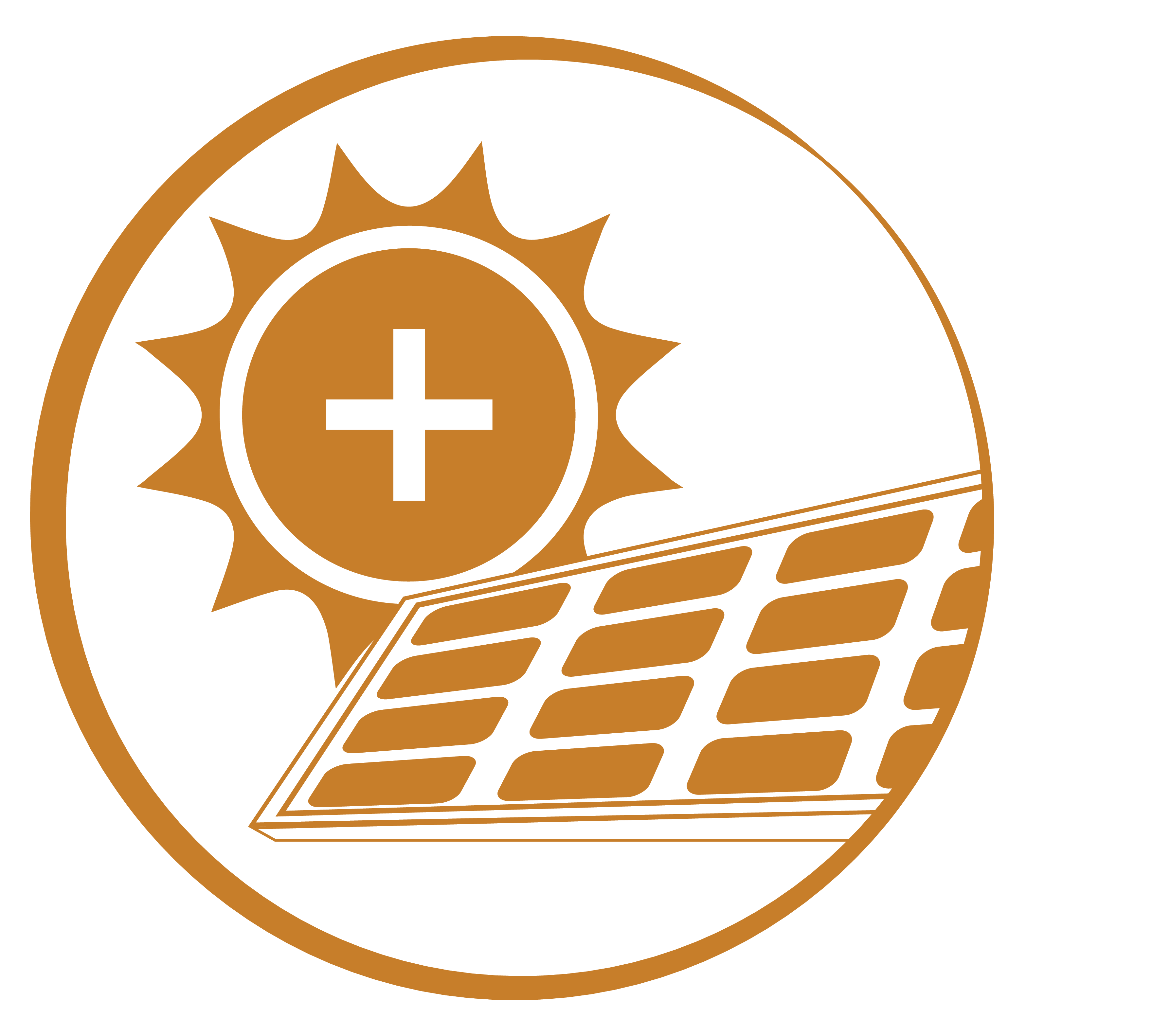
Here are the Advantages You Get with Solar Powered Lighting
Solar lights are extremely cost-effective. Many corporations, businesses, cities, etc. have saved thousands of dollars up-front and over time because of no grid-tie connections and no energy bills over time.
Solar lights are more secure—in times of emergency or a power failure, these lights stay on since there’s no connectivity to power grids that are liable to fail.
Versatility. Solar lighting works well for remote areas, cities, construction sites, parks, streetways, and other areas. Some models are portable, so you can move them wherever needed.
No trenching. Solar lighting systems don’t need trenching to connect to power, so the grounds in the area can be kept intact—this is important for parks and protected lands.
No electricity bills. You needn’t worry about lighting bills with solar since the panels draw free electricity from the sun!
Solar energy is one of the cleanest forms of energy. There are no emissions or by-products from generating energy from the sun.
Solar lighting is incredibly versatile. These ten applications show that businesses, municipalities, corporations, parks, and public places of all sorts can benefit from solar from numerous standpoints.
1. Solar Lighting for Streets
One of the largest reasons why municipalities choose solar for their street lighting is because of how much of a nuisance construction can be, especially if lights are previously installed in the area. That’s not the case with solar. A single solar light can be assembled and installed in less than two hours. No road closures, blocked-off construction sites, or loud drills in the morning. Here’s an example of a street lighting project that saved several thousands of dollars and kept the community’s grounds intact.
2. Parking Lot Lighting--Solutions Fast
Sometimes companies need solutions quickly. Solar lighting is a fantastic solution in lighting for parking lots since the average time it takes to install a system of solar lights (especially if pedestals are already present) is about 2 working days. Solar lights preserve parking lot pavement and keep commuters safe at night when safety can be a concern.
3. Park and Park Beautification
Park lighting is notorious for installation for two reasons: grounds and public access. The best idea for lighting a park is using solar—with quick, clean installation, lights can be erected in typically a day’s time once the pedestals are in place and dried. Plus, the best way to be in harmony with nature is to use the most efficient, naturally-sourced energy to power lighting.
4. Construction--Gotta Have Some Light
Solar lights are quick and easy to deploy. They can be left on location to recharge without the need for noisy, smelly generators that require refueling. Once the project they assist with is completed, they can be hauled to the next job site.
5. Military Solar Lighting
The military requires a standard that grid-tie options don’t always offer. Sometimes grid-tie can get messy, complicated, time-intensive, and expensive. Training areas and armories are intentionally left separate from a lot of power grids. Solar lights can be paired with motion sensors to instantly blip on at the first sign of any movement. Plus, if your solar installation needs to be managed remotely, each light can be integrated into a satellite monitoring system to ensure optimal functionality, even when nobody is around.
6. Security Where You Need it Most
When paired with a motion detector, solar lights can be used to deter theft, enhance security, and provide light on an as-needed basis. The batteries charge via the solar panels during the day and then provide power for the light fixtures at night. Lights for this application are often found in rural areas where open fields need light to work in. Solar lights are also placed in commercial and residential areas to prevent vandalism.
7. Airport Lighting
Sometimes airports require extra lighting in order for commuters to safely get from point to point. Airplanes on occasion will release passengers without a connecting gate at night. Solar lighting is perfect for such a situation—mobile solar towers or portable lights can be transported out onto the airport tarmac where the lights can guide passengers safely into the terminal.
8. Solar Retro-Fit Lighting
Are poles or pedestals in place, but with the lights out? Not a problem. Solar lighting can be installed onto older poles through a retro-fit process. This means less hassle and quicker installation, provided that the poles meet durability / quality standards.
9. Solar Sign Lighting
Solar lighting for signage is perfect for businesses looking for more cost-effective ways of lighting their signs. Oftentimes, billboard lighting can be problematic to power since signage is by roadways, near bushes and pavement, and can be costly to dig into the grounds to run power. Easement costs can multiply project fees and delay installation time, especially if the project is to light multiple signs in several different locations, each of them likely with unique configurations. With solar, you needn’t worry about permits or excessive trenching just for commuters to see your business signs at night.
10. Solar Canopy / Mailbox / Bus Stop Lighting
There are solar lighting options for canopies, mailboxes, and bus stops as well. Projects like these tend to focus lighting in small areas, so they tend to use fewer lights. You can customize your systems to fit the surroundings of the project area naturally. It’s near impossible to trench and wire for power in some mailbox areas, so solar is a natural option.
By far, one of the most significant reasons for purchasing solar lighting is due to the economic benefits of solar power. There are numerous monetary reasons to install a lighting system that uses solar power, so let’s take a look at each of them, with the most lucrative first.

Total Savings from Solar Power
Solar-Powered Lighting Doesn’t Require Trenching
Solar lighting uses photovoltaic technology to produce electricity—it doesn’t require electrical conduit, wiriring, or trenching. Numerous solar projects have saved customers several thousands of dollars on the first day of installation.
Save Money with Zero Energy Bills
The energy bill for traditional light costs $150-250 per year. Solar lighting uses the power of photovoltaics to produce electricity. This means that for the entire life of each solar lighting system, you won’t receive a monthly bill to pay.
State Incentives
There are a lot more than just federal incentives to make money back through your solar installation. Every state has plenty of incentives to discover, and most of them are listed through the Database of State Incentives for Renewables & Efficiency (DSIRE) website. Be sure to investigate what financial benefits are available to you immediately after your solar project is installed. Free money is always a great thing.
The Conclusion of Solar Power Economics
The technology behind solar power has decreased in price by 99.9% over the past 50 years, so the return on investment has only grown. Over time, we’ll see components drop to even lower prices as solar panel light technology (and the components that power the lights) improves, making the economics of solar lighting worth every penny. Based on a comprehensive cost analysis of solar lighting systems in comparison to its grid-tie counterparts, solar saves $3400-4000/ system over the time of ownership.
A solar light is a system of parts that work in harmony to generate power from solar exposure, store power, and re-use that power in an efficient manner to light a general or specific area. There are many variations to how the parts are configured in order to achieve the best result for its intended environment, but the overall structure is always there:
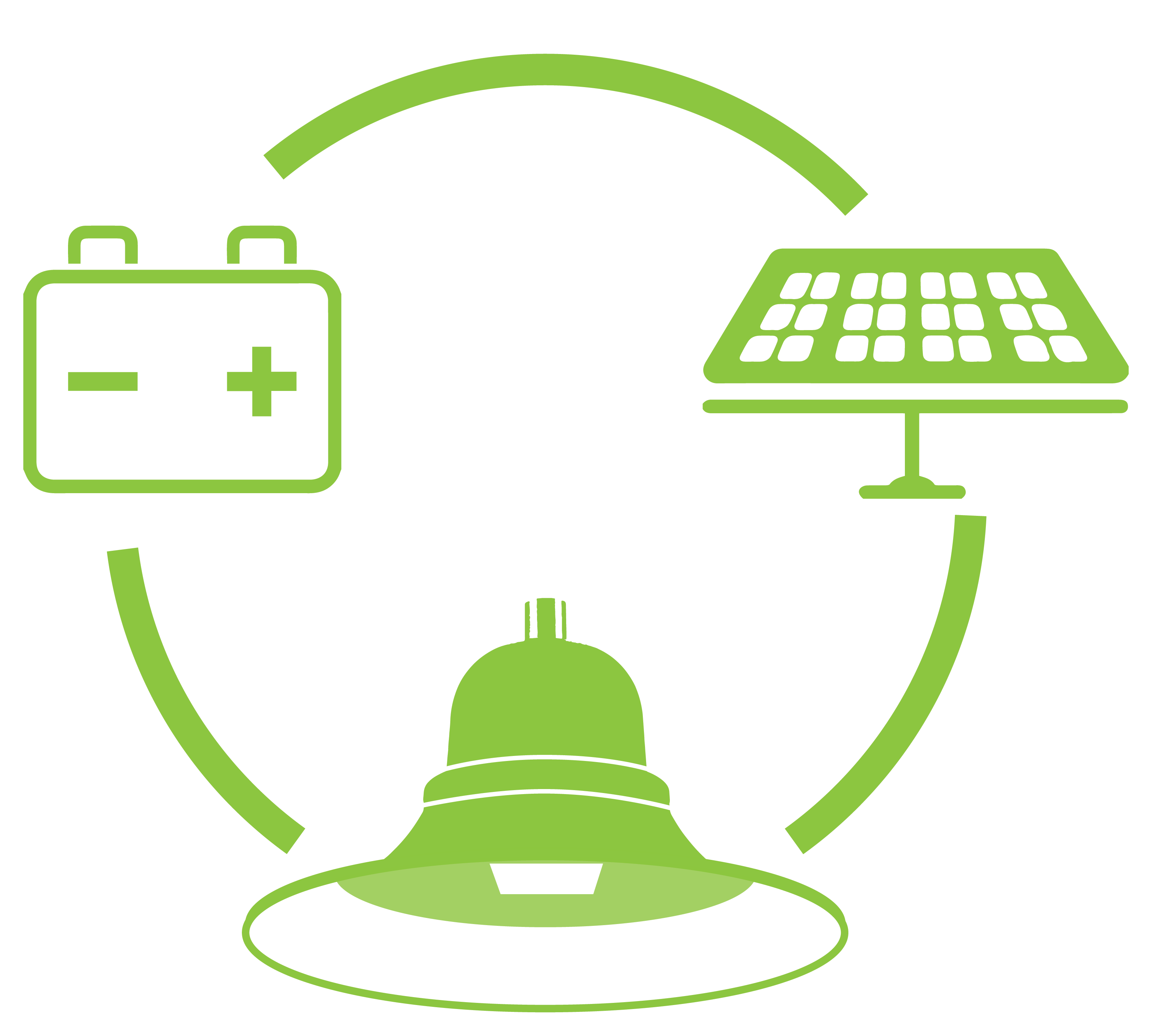
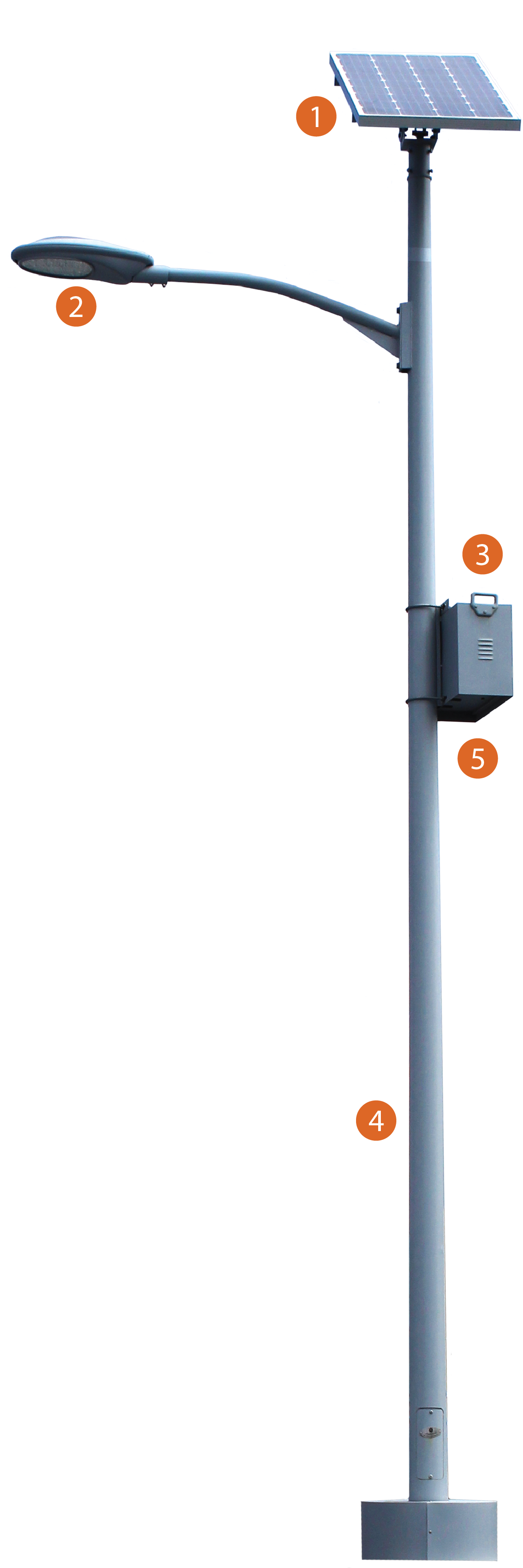 1. Panel
1. PanelEvery solar light ships with a full assembly of mounting hardware and angling brackets to ensure that the solar panel will be sturdy and properly angled to capture as much solar energy as possible. There must be a balance between material strength and weight since the panel will be sitting in a vulnerable position for years, facing weather fluctuations and wind.
The fixture is what houses a light. With solar LED lighting, fixtures come in arrays of several LED fixtures embedded into a full array. Quality fixtures are wired in a parallel configuration instead of series. Check your manufacturer documentation to learn about the wiring of your fixture.
LEDs have expanded the range of available fixtures. The most widely used fixture is a cobra head fixture, but since solar LED lighting is used in parks, alternative fixtures may be more aesthetically pleasing.
This controls the power between the light fixture, panel, and battery. Often the brains of the system, it can control the light output of the fixture and maintain battery health.
Quality poles are shipped with felt to prevent damage in transit. Solar light poles vary in height and material build in order to last—50 years is a common pole lifespan.
A battery comes with the proper wiring, battery box, and mounting materials. You can also opt to bury the battery underground to avoid cold temperatures. This step is typically done before the concrete pedestal is poured and cured.
Thankfully, there isn’t just “one type” of light fixture. Here are some common styles and their most common applications.
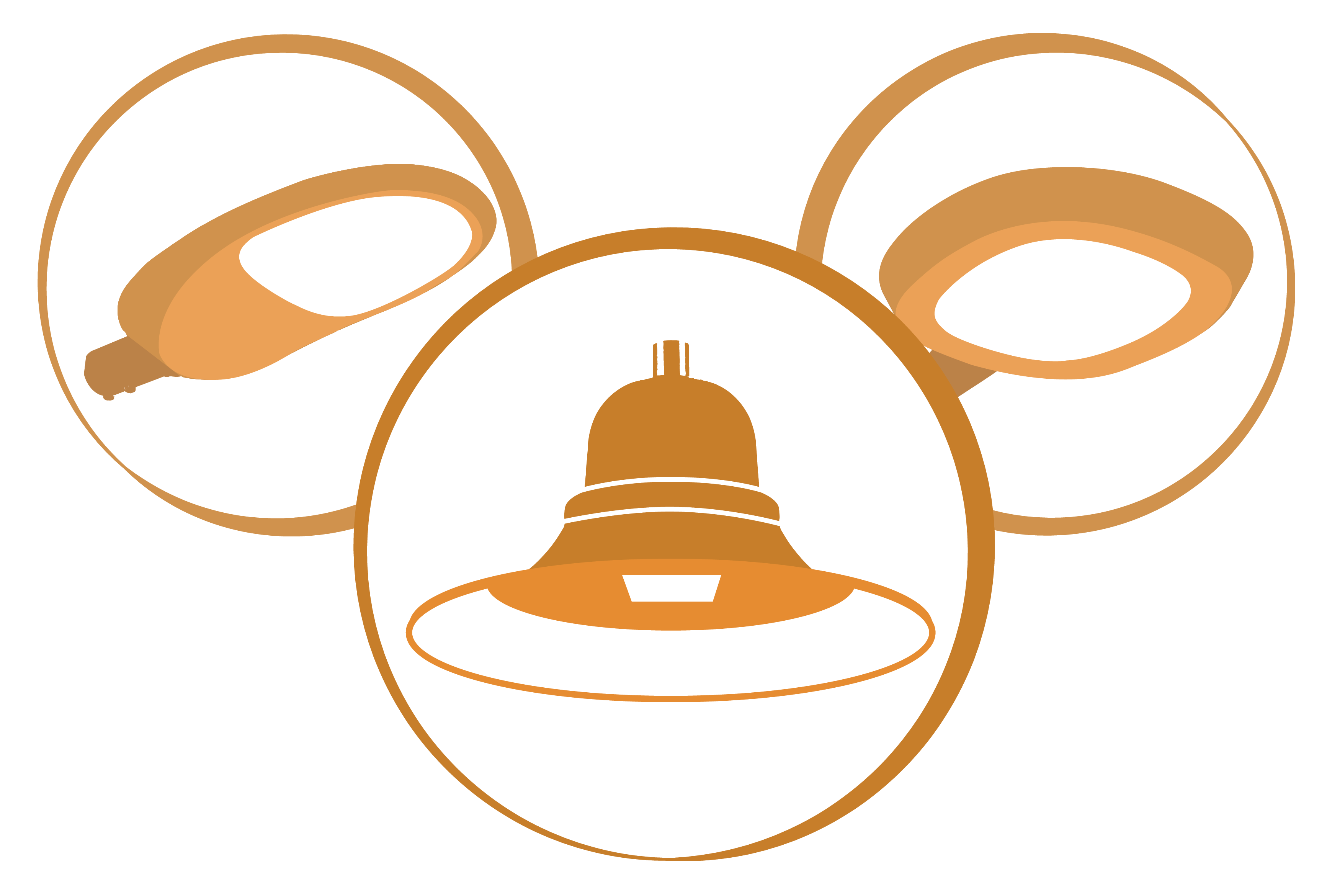
Cobra Head - The most common are cobra head and tend to fulfill a “catch-all” purpose. They strike a good balance between aesthetics and functionality. They’re mostly used in street, roadway, and parking lot lighting.
Decorative - These tend to have more “flair” to them like pendant mount fixtures. They’re fantastic for parks, boulevards, town squares, art districts, and other places where aesthetics are more important.
Bollard - These are short, pillar-like structures where the fixture is intended to light a pathway. The panels in these reside on the top of the bollard. Sometimes dollars serve as suggestive perimeters for walkways and landscaping.
Light Bar - These interesting fixtures are best for shelters, canopies, and bus stops. They’re very easy to install and, just like any other solar lighting solution, don’t need underground power connectivity to operate. The panels are usually set on top of the canopy structure or integrated into a solar power generator, which is set off to an unobstructed area.
All in One - These combine functionality with a space-saving aesthetic with a fixture, panel, and battery combined into one unit. They’re great for retrofit lighting applications where a pole is already installed but the previous fixture is out of proper order.
Spotlight - These are commonly used in lighting business and city entrance signs where grid electricity would be too costly. They’re extremely popular for billboards that reside on the side of highways.
Flood lights are very common fixtures in construction. These are not meant for field lighting, but rather for mobile projects that need a wide cast of light.
There are countless other fixtures, the vast majority of which aren’t applicable to public outdoor lighting, but these are a few common ones you’ll see used in solar lighting.
Light Emitting Diodes (LEDS) are the result of decades of research, work, technological development, and combined knowledge from several scientists and pioneers in the lighting field. They’re incredibly efficient for their lumen output in comparison to other lighting technologies and are perfect for pairing with solar panels to produce clean power that lasts all night long. Here are some standards to adhere to for quality.
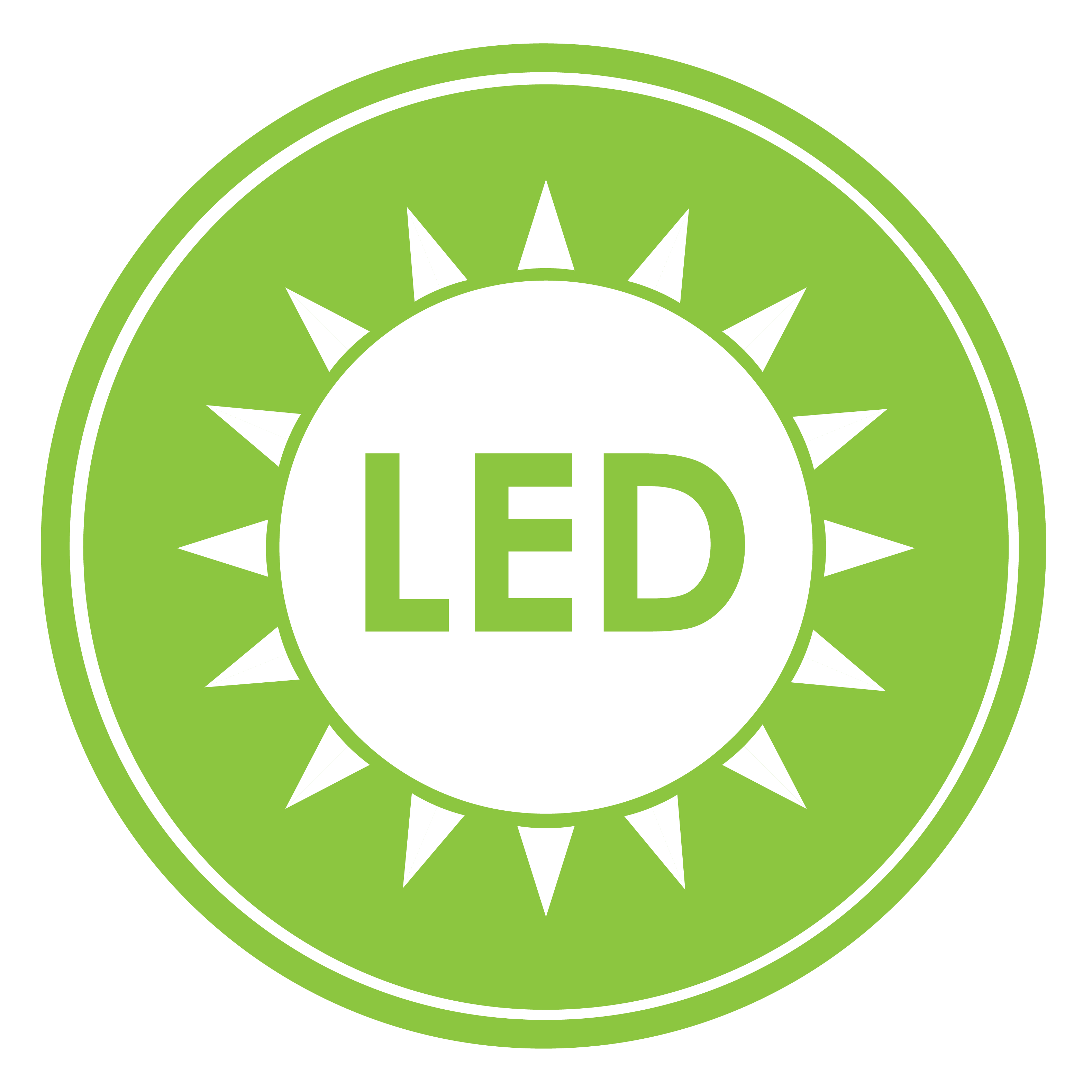
Color Temperature
White LEDs are the result of a phosphorus layer on top of a UV-emitting diode, but the phosphorus layer often determines the color temperature of the light. A common color temperature for LEDs is 4,000K, or a “cool white,” but this can be adjusted based on the needs for the client.
Color temperature for lighting is measured on the Kelvin scale between 1,000K to 10,000K, with 1,000 a much more “warm” color and 10,000K being a very “blue-white” light.
Distribution Types of LEDs
LEDs are arranged in different patterns for their fixtures. They’re named Type I through V. Here are the differences between them.
Generally, Type I and II fixtures are best for parks and walkways, so decorative fixtures are more common. The latter fixtures are best for functionality, which suggests parking lots and construction areas. Having the right fixture for the right application is a must.
Beam Angle
Beam Angle is the angle at which light is distributed from a light source. The specific degree measurement from a lamp varies depending on the manufacturer, but a beam angle falls under four categories:
Spot (5 - 20 degrees)
Flood (21 - 35 degrees)
Wide Flood (36 - 49 degrees)
Very Wide Flood (50 - 120 degrees)
Luminous Intensity Distribution Pattern
This pattern shows the direction and intensity of the light from the light source. Two graphs common in displaying the light patterns are called the plane system and the polar curve.
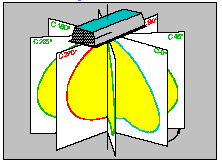
Plane
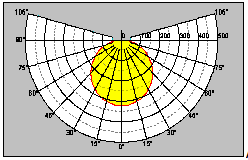
Polar
Batteries are complex devices because they take in electrical power, store it as a chemical, and then revert it back to electrical power when needed. Lead-Acid batteries have certain qualities about them that make them ideal for solar street lights:

Constant Charge-Discharge
Solar lights work on a daily cycle of gathering energy and utilizing energy--thus, you need a battery that can charge and discharge constantly. These kinds of batteries can take this constant rate of charge-discharge easily without losing too many power cycles.
Great Depth of Discharge
A depth of discharge refers to how much a battery can be safely discharged without too much energy to sacrifice. If a battery drains below the recommended level, it can sacrifice overall power cycles and battery health.
A lead-acid battery’s optimal DoD is about 15%. A properly-sized solar lighting system will most often drain the battery to this level. The max recommended level is 20% of the battery’s total power.
All-Weather Resilience
The batteries are self-heating, so if they’re out in the cold they’ll be able to withstand the temperature drop. They survive well in the heat. However, in some extreme climates, it may make more sense to bury them to maintain their optimal charge.
The Energy Management System (EMS) is an efficiency system that ensures energy is stored in the battery properly and then is delivered to the driver when the fixture needs it. The EMS consists of two components: the driver and the controller. These can either be separate components or a combined build. The driver for a solar light is detailed after this section.

How Controllers Work with Solar Lights
Controllers regulate power load between the panels and the batteries--they prevent the batteries from overcharging and stop reverse-current flow, or when electricity flows back from the batteries to the panels at night.
Autonomy Setting
Controllers can be set to energize the LED luminaires in several modes such as full output, full brightness with automatic shut-off (this setting may extend the system autonomy well beyond 5 nights), to split night (full output for first 5 hours and then to 40% for the remainder of evening), which will expand the autonomy from 5 to about 7 or 8 nights. This expands the life cycle of all the electronic components since they’re used less frequently.
What Does a Driver Do for an LED Light Fixture?
Drivers take raw incoming voltage (DC 12v) and alter it to 85 volts for the fixture. Controllers tell the drivers what to do with the light level. A fixture doesn’t just have one brightness setting--they can be dimmed at certain times at night to give the proper level of illumination for a subject. Without a driver, the LEDs would stay on at full brightness all of the time and burn too much of the stored solar energy as well as reduce the longevity of the LEDs in the fixture.
What’s important in solar lighting is that the design calculations are accurate. You can start this process by choosing the best fixture style for the particular type of application. Overhead fixtures provide better lighting for applications such as street, parking lot, pathways, etc, whereas sign lights and floodlights are good for directional lighting and wall washing. Check out the fixture styles section to see more details. There are other factors to consider when designing your system:
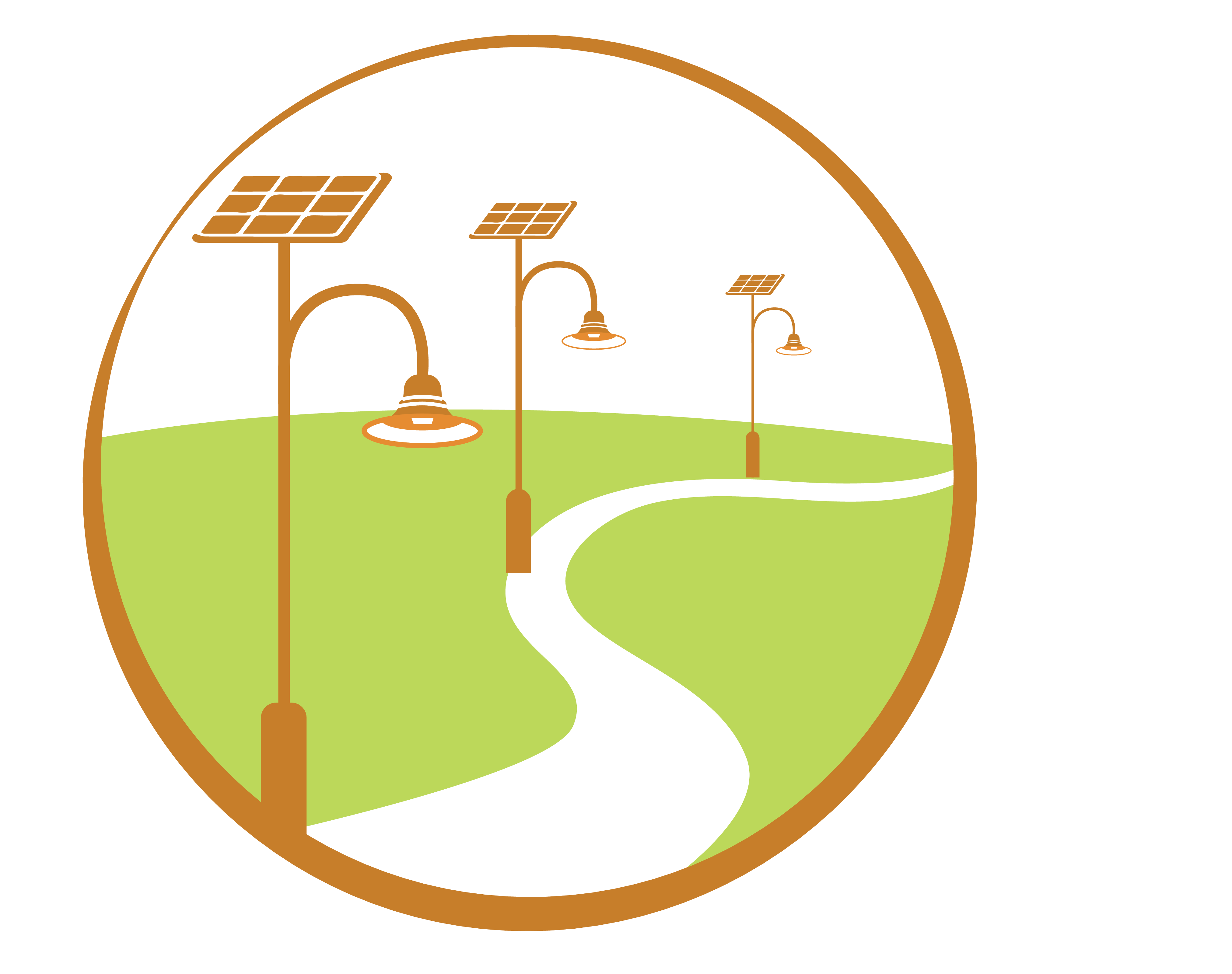
Light Spacing
The best spacing for light is determined by IESNA standards, but since each project is different, special areas or needs are considered. This is where a knowledgeable lighting consultant can help and get the best results for your project.
Unique Locations
Consider the locations of each light as they’re planned--solar panel obstructions are common in parks (trees) and metropolitan areas (skyscrapers). The surroundings for a project site are not always ideal for solar energy.
Use the Volta
The Volta series is a unique solar light that has the solar panel integrated into the pole. The panel wraps around the pole so it appears as one unit instead of two separate components. If you’re interested in the Volta for your project, be sure to consult a lighting engineer as the Volta is most efficient in certain locales.
Bury the Batteries
Batteries aren’t typically buried since after 5 years they’ll need to be replaced (average timespan). However, when presentation and aesthetics are more important than component accessibility, you can opt to place the battery underground. This is also a good way to regulate battery temperature if there are extreme temperatures to consider.
Compliance Considerations
There are some “checkmarks” that lights need to hit in order to be considered “best” for public use. The first is called International Dark Sky Association (IDA) Compliance. This is a set of guidelines to ensure lighting isn’t harmful to living organisms.
Light Spill
The IDA recommends light fixtures that do not have a “spillover” of light past the 180-degree plane of a fixture's angle. If light escapes the fixture past this plane for whatever reason, this is a telltale sign of a poor-quality fixture.
Color Temperature
IDA compliance for a light states that the color temperature given from the light fixture should be no more than 3000 Kelvin. Generally 5000K is considered “too blue” for outdoor lighting and it’s rarely used in outdoor lighting anymore since it’s been claimed to negatively influence sleep cycles in people. Some lighting fixtures can output less than 3000K depending on the project and customer specifications, but IDA compliance is no more than 3000K.
Have additional questions about Solar? We've covered the most commonly asked questions about solar lighting below. Also Feel free to download the PDF version of this solar guide at the bottom - in the PDF we covered each topic of this guide in more depth.

Frequently Asked Questions for Solar Lights
Q: Can solar street lights remain on during the evening even if we have cloudy days?
A: Yes, systems are designed to provide at least 5 nights of power even if you don’t have sun. We design our systems around the Winter Solstice where you have the shortest day and longest night. We accomplish this by analyzing your local solar/weather conditions to ensure our systems remain on at night when lighting is needed most.
Q: Can solar lights run out of energy?
Answer: Not from a quality manufacturer. Solar lights work almost anywhere, but it’s important to know how to configure a light in order to get the best functionality from it.
Q: Do some solar light systems lose power because of not enough solar energy?
A: Only improperly-sized systems will suffer significant power loss from poor sun hours.
Q: I live in a strong wind zone - are solar lights strong enough to withstand high winds?
A: Yes, most systems are designed for 140 mph winds. Some projects are located in hurricane zones that can handle winds up to 180 mph.
Q: What is the best solar panel technology for lighting needs?
A: “Best” is a bit of a subjective word. If you include “most commercially available” and “most researched,” the best in this case would be monocrystalline silicon panels. They’re more efficient than other technologies, use less harmful materials (like Cadmium), and use a heavily-researched, abundant base component.
Q: What is the difference between high-pressure sodium fixtures and LED fixtures?
A: LEDs cast more natural light on subjects. HPS light fixtures (which are still common) are efficient sources of light, but the quality of the light is poor. This poor light quality makes it hard to decipher colors properly; this can be an issue where safety is concerned.
Q: Can solar be harmful to the environment?
A: It depends on what the solar panel is composed of. Cadmium is a highly toxic metal used in some different technologies for solar power. “Green companies” only uses monocrystalline silicon in solar power panels, a form of sand.
Q: Where does solar not work well enough to sustain the light fixtures?
A: Every situation is different, but oftentimes solar won’t work well in downtown areas where the sun is blocked by skyscrapers and other obstructions. Also, solar is a great solution for most, but not every situation or geographic location.
Q: How much money do I save with solar lighting?
A: Once again, every situation is different, but on average there’s a savings of about 20% of the original cost of the project if grid-tie lights were chosen. There are case studies where we have saved businesses approximately half a million dollars purely on trenching and wiring fees alone. That doesn’t factor in savings from energy and maintenance bills.
Q: What kind of maintenance should be done on solar street lights?
A: Solar lighting systems are essentially maintenance-free. Occasional rainfall usually keeps the panels fairly clean. If in an area where snow gets heavy, you may need to brush off the solar panels. However, given the solar panel’s angle, snow usually slides right off once the sun rises and the temperature goes up.
Q. How long will the batteries last for solar street lights?
A: Batteries typically last 5-7 years.
This solar lighting guide is intended to help you understand what to look for when you’re searching for quality parts that will justify your investment, reduce confusion over what components serve what function, and ensure your solar lighting project will last long-term.

We hope this knowledge base is sufficient enough for you to gain an understanding of how a solar light works, what the pitfalls are, and how you can safely determine what product and manufacturer are right for your project.
All images used in this knowledge base are either A) property of Greenshine New Energy, B) used under the Creative Commons Public Domain License, or C) used with permission from the original creator.
Want to save the guide and read later?
